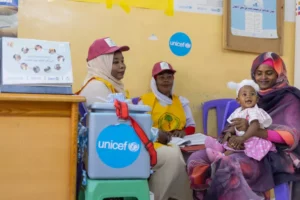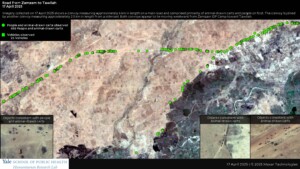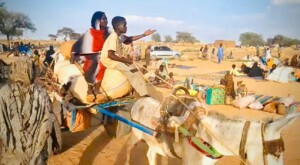Sudan OCHA bulletin 41: 65 percent of rain-fed areas planted
The Office for the Coordination of Humanitarian Affairs (OCHA) in Sudan reported in its latest weekly bulletin that improved rains have led to the planting of up to 65 percent of rain-fed areas in Sudan. 23,000 displaced in Blue Nile state need aid. In North Darfur’s El Sereif locality, whooping cough broke out. Malnourished children in Kutum and Kalamindo localities receive treatment in nutrition centres.
The Office for the Coordination of Humanitarian Affairs (OCHA) in Sudan reported in its latest weekly bulletin that improved rains have led to the planting of up to 65 percent of rain-fed areas in Sudan. 23,000 displaced in Blue Nile state need aid. In North Darfur's El Sereif locality, whooping cough broke out. Malnourished children in Kutum and Kalamindo localities receive treatment in nutrition centres.
By mid-September, up to 65 percent of agricultural lands in rain-fed areas have been planted, as opposed to only 40 percent planted in August. However, vegetation conditions are well below average in the surplus-producing sorghum belt in eastern and central Sudan, according to the latest Famine Early Warning Systems (FEWS NET) Food Security Outlook Update for September.
The most food insecure people in Sudan continue to be in the conflict-affected areas of Darfur, South and West Kordofan, and Blue Nile states.
There is also less and poorer quality pasture land available than usual this year and as a result, livestock are already being migrated southward towards agricultural land in eastern Sudan and El states, a migration that usually takes place only in December-January, during or just after the harvest period. As crops are in an earlier stage of development, there is a higher risk of crops being accidentally destroyed or consumed by livestock.
According to FEWS NET, the delayed rainfall, rainfall shortage and intermittent dry spells that have characterized the current rainy season in Sudan have all been driven by El Nino warming.
23,000 displaced in Blue Nile state need aid
In late September, the World Food Programme (WFP) conducted a rapid food security assessment in five locations in Blue Nile State to determine the needs of displaced from Bau locality. According to the mission report, about 23,000 people moved to five locations in Ed Damazin, El Roseires, and Bau localities.
The displaced people were found living in temporary housing built of grass and bamboo, which does not provide adequate protection from the rains. They said they will remain in these areas until their places of origin are secure again. Food was identified as the major need.
Recommendations from the mission include WFP providing the displaced with full food rations for three months until the September-November harvest is completed. Food distributions started this week.
Whooping cough outbreak in North Darfur
As of 7 October, 323 suspected cases of whooping cough were reported in El Sereif Beni Hussein locality. The North Darfur Ministry of Health and the World Health Organization (WHO) are coordinating the response with partners to ensure that daily reporting, proper case management and effective community mobilisation campaigns take place. A three-month action plan has been prepared to deal with the outbreak of the highly contagious disease.
Malnourished children in North Darfur’s Kutum and Kalamindo screened
The international GOAL organisation conducted a Mid-Upper Arm Circumference (MUAC) screening of children between 6 to 59 months of age in Kutum town and the Kassab and Fata Borno camps for the displaced in September. Of the 1,636 children screened, 55 children were identified with severe acute malnutrition (SAM), and 316 with moderate acute malnutrition (MAM). All malnourished children were referred to nutrition centres for treatment.
Similarly, Save the Children Sweden conducted a MUAC screening in four villages in Kalamindo locality. Of the 3,128 children under five screened 96 were identified with SAM and 241 with MAM. The affected children were provided with the required treatment.
GAM is the total number of children aged between six months and 5 years in a given population who have MAM and SAM. According to WHO, in emergencies, the nutritional status of children between six months and 5 years is used as an estimation of the health of the whole population so when GAM is equal to or greater than 15 per cent then the nutrition level for the population is defined as ‘critical’.
South Darfur humanitarian response update
According to aid organisations in South Darfur, an estimated 840,000 displaced people in the state -which is about 34 percent of the displaced population in Sudan- are living in eight camps, 13 settlements, and amongst 40 host communities.
Early October, World Vision International (WVI) distributed one-month food rations of WFP food to over 300 newly displaced people in Dereig camp. They also received emergency shelter and household supplies.
The UN children’s Agency (Unicef) reports that since the beginning of the year, the total number of children under five years treated for SAM in the state reached 18,953 – which is 42 percent of the 45,175 children targeted for SAM treatment in the state.
Unicef and the state Water and Sanitation Department (WES) are working to restore the water provision for the about 3,300 displaced living in Nyala's Mosey camp in Nyala.
Read the full bulletin here











 and then
and then